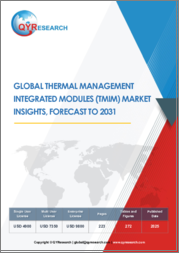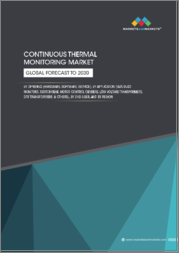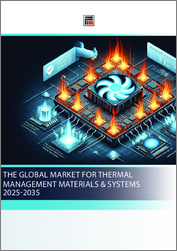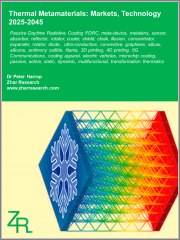
|
시장보고서
상품코드
1621516
세계의 열 관리 시장 : 재료 유형, 디바이스, 서비스, 최종 용도별 예측(2025-2030년)Thermal Management Market by Material Type (Adhesive Material, Non-adhesive Material), Device (Advanced Cooling Devices, Conduction Cooling Devices, Convection Cooling Devices), Service, End-use - Global Forecast 2025-2030 |
||||||
열관리 시장은 2023년 143억 9,000만 달러로 평가되었고, 2024년에는 158억 1,000만 달러에 이를 것으로 예측되며, CAGR 9.99%로 성장하며 2030년에는 280억 3,000만 달러가 될 것으로 예측됩니다.
열 관리는 시스템과 장치의 온도 제어를 목적으로 한 기술과 기술을 포함한 다양한 산업에 매우 중요한 측면입니다. 자동차 기술에 대한 수요가 증가함에 따라 이들은 모두 최적의 기능과 수명을 보장하기 위해 효과적인 방열을 필요로 합니다. 또한 최종 용도로는 데이터센터, 전기자동차, 산업기계 등이 포함됩니다. 데이터센터의 세계 확대 등의 요인에 의해 추진되고 있습니다. 기술 혁신 기업은 보다 효율적이고 지속 가능한 열 관리 솔루션을 창출하기 위한 연구 개발에 투자함으로써 이러한 기회를 활용할 수 있습니다. 높은 비용과 첨단 냉각 솔루션을 기존 인프라에 통합하는 기술적 과제 등 시장은 한계에 직면하고 있습니다. 비용 효율 높은 재료 개발, 열 분석을위한 고급 시뮬레이션 도구, 실시간 열 관리를 위한 IoT 통합에 초점을 맞출 수 있습니다. 시장은 역동적이며 기업은 경쟁력을 유지하기 위해 민첩하고 선견적이어야 합니다.
| 주요 시장 통계 | |
|---|---|
| 기준연도(2023) | 143억 9,000만 달러 |
| 추정연도(2024) | 158억 1,000만 달러 |
| 예측연도(2030) | 280억 3,000만 달러 |
| CAGR(%) | 9.99% |
시장 역학: 급속히 진화하는 열 관리 시장의 주요 시장 인사이트 공개
열관리 시장은 수요 및 공급의 역동적인 상호작용에 의해 변모를 이루고 있습니다. 그리고 새로운 비즈니스 기회 획득에 대비할 수 있습니다. 이러한 동향을 종합적으로 파악함으로써 기업은 정치적, 지리적, 기술적, 사회적, 경제적인 영역에 걸친 다양한 리스크를 경감할 수 있음과 동시에 소비자 행동과 그것이 제조 비용과 구매 동향에 미치는 영향을 보다 명확하게 이해할 수 있습니다.
- 시장 성장 촉진요인
- 소비자용 전자기기의 소형화의 동향과 고도의 방열 솔루션의 필요성
- 신재생에너지원의 채용을 추진하는 정부 이니셔티브 증가
- 전기자동차 제조업체의 열 관리 솔루션에 대한 높은 수요
- 시장 성장 억제요인
- 커스터마이즈된 배터리 열 관리 솔루션의 개발·운용 비용의 높이
- 시장 기회
- 새로운 열 관리 솔루션 개발에 대한 지속적인 노력
- 맞춤형 열 관리 솔루션의 진화
- 시장의 과제
- 열 관리와 관련된 재료의 열 성능의 한계와 문제점
Porter's Five Force : 열 관리 시장을 탐색하는 전략 도구
Porter's Five Force Framework는 열 관리 시장 경쟁 구도를 이해하는 중요한 도구입니다. 기업이 시장 내 세력도를 평가하고 신규 사업의 수익성을 판단하는 데 도움이 됩니다. 피할 수 있으며 더 강인한 시장에서 포지셔닝을 보장 할 수 있습니다.
PESTLE 분석 : 열 관리 시장에서 외부로부터의 영향 파악
외부 거시 환경 요인은 열 관리 시장의 성과 역학을 형성하는 데 매우 중요한 역할을합니다. 를 탐색하는 데 필요한 정보를 제공합니다. PESTLE 요인을 조사함으로써 기업은 잠재적인 위험과 기회를 더 잘 이해할 수 있습니다. 적극적인 의사 결정을 할 준비가되어 있습니다.
시장 점유율 분석 : 열 관리 시장에서 경쟁 구도 파악
열 관리 시장의 상세한 시장 점유율 분석을 통해 공급업체의 성과를 종합적으로 평가할 수 있습니다. 분명히 이 분석을 통해 시장 집중, 단편화, 통합 동향을 밝혀내고 벤더는 경쟁이 치열해지는 가운데 자신의 지위를 높이는 전략적 의사결정을 하기 위해 필요한 지견을 얻을 수 있습니다.
FPNV 포지셔닝 매트릭스 : 열 관리 시장에서 공급업체의 성능 평가
FPNV 포지셔닝 매트릭스는 열 관리 시장에서 벤더를 평가하는 중요한 도구입니다. 기본 결정을 내릴 수 있습니다. 네 가지 사분면을 통해 벤더를 명확하고 정확하게 분할하고 전략 목표에 가장 적합한 파트너 및 솔루션을 파악할 수 있습니다.
전략 분석 및 추천 : 열 관리 시장에서 성공을 위한 길을 그리기
열 관리 시장의 전략 분석은 세계 시장에서의 현장 강화를 목표로 하는 기업에 필수적인 요소입니다. 이러한 접근 방식을 통해 경쟁 구도에서 과제를 극복하고 새로운 비즈니스 기회를 활용하여 장기적인 성공을 거둘 수 있는 체제를 구축할 수 있습니다.
이 보고서는 주요 관심 분야를 포괄하는 시장의 종합적인 분석을 제공합니다.
1. 시장 침투: 현재 시장 환경의 상세한 검토, 주요 기업의 광범위한 데이터, 시장 도달범위 및 전반적인 영향력 평가.
2. 시장 개척도: 신흥 시장의 성장 기회를 파악하고 기존 분야의 확장 가능성을 평가하며 미래 성장을 위한 전략적 로드맵을 제공합니다.
3. 시장 다양화: 최근 제품 출시, 미개척 지역, 업계의 주요 진보, 시장을 형성하는 전략적 투자를 분석합니다.
4. 경쟁 평가 및 정보 : 경쟁 구도를 철저히 분석하여 시장 점유율, 사업 전략, 제품 포트폴리오, 인증, 규제 당국 승인, 특허 동향, 주요 기업의 기술 진보 등을 검증합니다.
5. 제품 개발 및 혁신 : 미래 시장 성장을 가속할 것으로 예상되는 최첨단 기술, R&D 활동, 제품 혁신을 강조합니다.
또한 이해관계자가 충분한 정보를 얻고 의사결정을 할 수 있도록 중요한 질문에 대답하고 있습니다.
1. 현재 시장 규모와 향후 성장 예측은?
2. 최고의 투자 기회를 제공하는 제품, 부문 및 지역은 어디입니까?
3. 시장을 형성하는 주요 기술 동향과 규제의 영향은?
4. 주요 벤더의 시장 점유율과 경쟁 포지션은?
5. 벤더 시장 진입·철수 전략의 원동력이 되는 수익원과 전략적 기회는 무엇인가?
목차
제1장 서문
제2장 조사 방법
제3장 주요 요약
제4장 시장 개요
제5장 시장 인사이트
- 시장 역학
- 성장 촉진요인
- 소형 가전 트렌드와 첨단 방열 솔루션의 필요성
- 신재생에너지원의 도입을 촉진하는 정부의 대처의 강화
- 전기자동차 제조업체의 열 관리 솔루션에 대한 높은 수요
- 억제요인
- 맞춤형 및 배터리 열 관리 솔루션과 관련된 높은 개발 및 운영 비용
- 기회
- 새로운 열 관리 솔루션 개발을 위한 지속적인 노력
- 맞춤형 열 관리 솔루션의 진화
- 과제
- 재료의 열 성능의 한계와 열 관리와 관련된 문제
- 성장 촉진요인
- 시장 세분화 분석
- 재료 유형: 열 관리 솔루션에서 접착 재료 사용 증가
- 최종 용도 : 자동차 및 가전제품에 있어서의 열관리의 급속한 채용
- Porter's Five Forces 분석
- PESTEL 분석
- 정치적
- 경제
- 사교
- 기술적
- 법률상
- 환경
제6장 열 관리 시장 : 소재 유형별
- 점착재
- 접착제액
- 필름
- 테이프
- 비점착성 소재
- 갭 필러
- 그리스
- 상변화물질
- 열 패드
제7장 열 관리 시장 : 디바이스별
- 고급 냉각 장치
- 전도 냉각 장치
- 대류 냉각 장치
- 하이브리드 냉각 장치
제8장 열관리 시장 : 서비스별
- 설치 및 교정
- 최적화 및 애프터 지원
제9장 열관리 시장 : 최종 용도별
- 항공우주 및 방어
- 자동차
- 가전
- 기업
- 헬스케어
- 서버 및 데이터센터
제10장 아메리카의 열관리 시장
- 아르헨티나
- 브라질
- 캐나다
- 멕시코
- 미국
제11장 아시아태평양의 열 관리 시장
- 호주
- 중국
- 인도
- 인도네시아
- 일본
- 말레이시아
- 필리핀
- 싱가포르
- 한국
- 대만
- 태국
- 베트남
제12장 유럽·중동 및 아프리카의 열 관리 시장
- 덴마크
- 이집트
- 핀란드
- 프랑스
- 독일
- 이스라엘
- 이탈리아
- 네덜란드
- 나이지리아
- 노르웨이
- 폴란드
- 카타르
- 러시아
- 사우디아라비아
- 남아프리카
- 스페인
- 스웨덴
- 스위스
- 터키
- 아랍에미리트(UAE)
- 영국
제13장 경쟁 구도
- 시장 점유율 분석 2023
- FPNV 포지셔닝 매트릭스, 2023
- 경쟁 시나리오 분석
- Marelli, 전기자동차용의 새로운 통합형 열 관리 모듈을 발표, 효율, 안전성, 주행 거리를 최대 20% 향상
- Carrar와 Gentherm이 협력하여 전기자동차(EV) 배터리 모듈용 견고한 2상 침지 열 관리를 제공
- The Heico Companies, 서멀 솔루션 부문 확대를 위해 Precision Engineering 인수 발표
- 전략 분석과 제안
기업 목록
- 3M Company
- ABB Ltd.
- Advanced Cooling Technologies, Inc.
- ALD Ltd.
- AMETEK, Inc.
- AVL List GmbH
- BorgWarner Inc.
- Continental AG
- CTS Corporation
- Delta Electronics, Inc.
- EG Electronics Group
- General Electric Company
- Gentherm Incorporated
- Honeywell International Inc.
- HYDAC International GmbH
- Infineon Technologies AG
- Inspiraz Technology Pte Ltd.
- Laird Technologies, Inc.
- Lubrizol Corporation
- MAHLE GmbH
- Melexis NV
- Mitsubishi Heavy Industries, Ltd.
- Momentive Performance Materials Inc.
- Multi Circuit Boards Ltd.
- Noren Thermal Solutions
- NORMA Group SE
- Panasonic Holdings Corporation
- Parker-Hannifin Corporation
- Robert Bosch GmbH
- Siemens AG
- Stockwell Elastomerics Inc.
- TDK Corporation
- The HEICO Companies LLC
- Thermal Management Solutions Group
- Vertiv Corporation
- Webasto SE
- Ymer Technology AB
The Thermal Management Market was valued at USD 14.39 billion in 2023, expected to reach USD 15.81 billion in 2024, and is projected to grow at a CAGR of 9.99%, to USD 28.03 billion by 2030.
Thermal management is a crucial aspect of various industries, encompassing techniques and technologies aimed at controlling the temperature of systems and devices. Its necessity arises from the growing demand for high-performance electronic devices, efficient energy systems, and reliable automotive technologies, all of which require effective heat dissipation to ensure optimal functionality and longevity. Applications span across sectors such as electronics, automotive, aerospace, and renewable energy, where end-use includes data centers, electric vehicles, and industrial machinery, among others. The market for thermal management is propelled by factors like the burgeoning growth of the electronics industry, the increasing adoption of electric vehicles with stringent thermal requirements, and the expansion of data centers globally to support cloud computing and AI activities. Growth opportunities lie in the development of advanced materials like phase change materials and thermally conductive polymers, as well as innovations in cooling technologies, such as liquid cooling systems for data centers. Companies can capitalize on these opportunities by investing in research and development to create more efficient and sustainable thermal management solutions. However, the market faces limitations, including high costs associated with innovation in materials and thermal management systems, and the technical challenges of integrating advanced cooling solutions into existing infrastructure. Regulatory standards and the need for sustainable practices also pose challenges. Innovation and research could focus on the development of eco-friendly and cost-effective materials, advanced simulation tools for thermal analysis, and integration of IoT for real-time thermal management. The nature of the market is dynamic, driven by rapid technological advancements and changing consumer needs, requiring businesses to be agile and forward-thinking to maintain competitiveness. Companies that prioritize sustainable practices and invest in cutting-edge technologies are poised to lead in this evolving market landscape.
| KEY MARKET STATISTICS | |
|---|---|
| Base Year [2023] | USD 14.39 billion |
| Estimated Year [2024] | USD 15.81 billion |
| Forecast Year [2030] | USD 28.03 billion |
| CAGR (%) | 9.99% |
Market Dynamics: Unveiling Key Market Insights in the Rapidly Evolving Thermal Management Market
The Thermal Management Market is undergoing transformative changes driven by a dynamic interplay of supply and demand factors. Understanding these evolving market dynamics prepares business organizations to make informed investment decisions, refine strategic decisions, and seize new opportunities. By gaining a comprehensive view of these trends, business organizations can mitigate various risks across political, geographic, technical, social, and economic domains while also gaining a clearer understanding of consumer behavior and its impact on manufacturing costs and purchasing trends.
- Market Drivers
- Trend of miniature consumer electronics and need for advanced heat dissipation solutions
- Increasing government initiatives promoting the adoption of renewable energy sources
- High demand for thermal management solutions from electric vehicle manufacturers
- Market Restraints
- High development and operating cost associated with customized and battery thermal management solutions
- Market Opportunities
- Ongoing initiatives to develop new thermal management solutions
- Evolution of customized thermal management solutions
- Market Challenges
- Limited thermal performance of materials and problems related to thermal management
Porter's Five Forces: A Strategic Tool for Navigating the Thermal Management Market
Porter's five forces framework is a critical tool for understanding the competitive landscape of the Thermal Management Market. It offers business organizations with a clear methodology for evaluating their competitive positioning and exploring strategic opportunities. This framework helps businesses assess the power dynamics within the market and determine the profitability of new ventures. With these insights, business organizations can leverage their strengths, address weaknesses, and avoid potential challenges, ensuring a more resilient market positioning.
PESTLE Analysis: Navigating External Influences in the Thermal Management Market
External macro-environmental factors play a pivotal role in shaping the performance dynamics of the Thermal Management Market. Political, Economic, Social, Technological, Legal, and Environmental factors analysis provides the necessary information to navigate these influences. By examining PESTLE factors, businesses can better understand potential risks and opportunities. This analysis enables business organizations to anticipate changes in regulations, consumer preferences, and economic trends, ensuring they are prepared to make proactive, forward-thinking decisions.
Market Share Analysis: Understanding the Competitive Landscape in the Thermal Management Market
A detailed market share analysis in the Thermal Management Market provides a comprehensive assessment of vendors' performance. Companies can identify their competitive positioning by comparing key metrics, including revenue, customer base, and growth rates. This analysis highlights market concentration, fragmentation, and trends in consolidation, offering vendors the insights required to make strategic decisions that enhance their position in an increasingly competitive landscape.
FPNV Positioning Matrix: Evaluating Vendors' Performance in the Thermal Management Market
The Forefront, Pathfinder, Niche, Vital (FPNV) Positioning Matrix is a critical tool for evaluating vendors within the Thermal Management Market. This matrix enables business organizations to make well-informed decisions that align with their goals by assessing vendors based on their business strategy and product satisfaction. The four quadrants provide a clear and precise segmentation of vendors, helping users identify the right partners and solutions that best fit their strategic objectives.
Strategy Analysis & Recommendation: Charting a Path to Success in the Thermal Management Market
A strategic analysis of the Thermal Management Market is essential for businesses looking to strengthen their global market presence. By reviewing key resources, capabilities, and performance indicators, business organizations can identify growth opportunities and work toward improvement. This approach helps businesses navigate challenges in the competitive landscape and ensures they are well-positioned to capitalize on newer opportunities and drive long-term success.
Key Company Profiles
The report delves into recent significant developments in the Thermal Management Market, highlighting leading vendors and their innovative profiles. These include 3M Company, ABB Ltd., Advanced Cooling Technologies, Inc., ALD Ltd., AMETEK, Inc., AVL List GmbH, BorgWarner Inc., Continental AG, CTS Corporation, Delta Electronics, Inc., EG Electronics Group, General Electric Company, Gentherm Incorporated, Honeywell International Inc., HYDAC International GmbH, Infineon Technologies AG, Inspiraz Technology Pte Ltd., Laird Technologies, Inc., Lubrizol Corporation, MAHLE GmbH, Melexis NV, Mitsubishi Heavy Industries, Ltd., Momentive Performance Materials Inc., Multi Circuit Boards Ltd., Noren Thermal Solutions, NORMA Group SE, Panasonic Holdings Corporation, Parker-Hannifin Corporation, Robert Bosch GmbH, Siemens AG, Stockwell Elastomerics Inc., TDK Corporation, The HEICO Companies LLC, Thermal Management Solutions Group, Vertiv Corporation, Webasto SE, and Ymer Technology AB.
Market Segmentation & Coverage
This research report categorizes the Thermal Management Market to forecast the revenues and analyze trends in each of the following sub-markets:
- Based on Material Type, market is studied across Adhesive Material and Non-adhesive Material. The Adhesive Material is further studied across Adhesive Liquids, Films, and Tapes. The Non-adhesive Material is further studied across Gap Fillers, Grease, Phase Change Materials, and Thermal Pads.
- Based on Device, market is studied across Advanced Cooling Devices, Conduction Cooling Devices, Convection Cooling Devices, and Hybrid Cooling Devices.
- Based on Service, market is studied across Installation & Caliberation and Optimization & Post-Sale Support.
- Based on End-use, market is studied across Aerospace & Defense, Automotive, Consumer Electronics, Enterprises, Healthcare, and Servers & Data Centers.
- Based on Region, market is studied across Americas, Asia-Pacific, and Europe, Middle East & Africa. The Americas is further studied across Argentina, Brazil, Canada, Mexico, and United States. The United States is further studied across California, Florida, Illinois, New York, Ohio, Pennsylvania, and Texas. The Asia-Pacific is further studied across Australia, China, India, Indonesia, Japan, Malaysia, Philippines, Singapore, South Korea, Taiwan, Thailand, and Vietnam. The Europe, Middle East & Africa is further studied across Denmark, Egypt, Finland, France, Germany, Israel, Italy, Netherlands, Nigeria, Norway, Poland, Qatar, Russia, Saudi Arabia, South Africa, Spain, Sweden, Switzerland, Turkey, United Arab Emirates, and United Kingdom.
The report offers a comprehensive analysis of the market, covering key focus areas:
1. Market Penetration: A detailed review of the current market environment, including extensive data from top industry players, evaluating their market reach and overall influence.
2. Market Development: Identifies growth opportunities in emerging markets and assesses expansion potential in established sectors, providing a strategic roadmap for future growth.
3. Market Diversification: Analyzes recent product launches, untapped geographic regions, major industry advancements, and strategic investments reshaping the market.
4. Competitive Assessment & Intelligence: Provides a thorough analysis of the competitive landscape, examining market share, business strategies, product portfolios, certifications, regulatory approvals, patent trends, and technological advancements of key players.
5. Product Development & Innovation: Highlights cutting-edge technologies, R&D activities, and product innovations expected to drive future market growth.
The report also answers critical questions to aid stakeholders in making informed decisions:
1. What is the current market size, and what is the forecasted growth?
2. Which products, segments, and regions offer the best investment opportunities?
3. What are the key technology trends and regulatory influences shaping the market?
4. How do leading vendors rank in terms of market share and competitive positioning?
5. What revenue sources and strategic opportunities drive vendors' market entry or exit strategies?
Table of Contents
1. Preface
- 1.1. Objectives of the Study
- 1.2. Market Segmentation & Coverage
- 1.3. Years Considered for the Study
- 1.4. Currency & Pricing
- 1.5. Language
- 1.6. Stakeholders
2. Research Methodology
- 2.1. Define: Research Objective
- 2.2. Determine: Research Design
- 2.3. Prepare: Research Instrument
- 2.4. Collect: Data Source
- 2.5. Analyze: Data Interpretation
- 2.6. Formulate: Data Verification
- 2.7. Publish: Research Report
- 2.8. Repeat: Report Update
3. Executive Summary
4. Market Overview
5. Market Insights
- 5.1. Market Dynamics
- 5.1.1. Drivers
- 5.1.1.1. Trend of miniature consumer electronics and need for advanced heat dissipation solutions
- 5.1.1.2. Increasing government initiatives promoting the adoption of renewable energy sources
- 5.1.1.3. High demand for thermal management solutions from electric vehicle manufacturers
- 5.1.2. Restraints
- 5.1.2.1. High development and operating cost associated with customized and battery thermal management solutions
- 5.1.3. Opportunities
- 5.1.3.1. Ongoing initiatives to develop new thermal management solutions
- 5.1.3.2. Evolution of customized thermal management solutions
- 5.1.4. Challenges
- 5.1.4.1. Limited thermal performance of materials and problems related to thermal management
- 5.1.1. Drivers
- 5.2. Market Segmentation Analysis
- 5.2.1. Material Type: Growing usage of adhesive materials for thermal management solutions
- 5.2.2. End-Use: Rapid adoption of thermal management in automotive and consumer electronics
- 5.3. Porter's Five Forces Analysis
- 5.3.1. Threat of New Entrants
- 5.3.2. Threat of Substitutes
- 5.3.3. Bargaining Power of Customers
- 5.3.4. Bargaining Power of Suppliers
- 5.3.5. Industry Rivalry
- 5.4. PESTLE Analysis
- 5.4.1. Political
- 5.4.2. Economic
- 5.4.3. Social
- 5.4.4. Technological
- 5.4.5. Legal
- 5.4.6. Environmental
6. Thermal Management Market, by Material Type
- 6.1. Introduction
- 6.2. Adhesive Material
- 6.2.1. Adhesive Liquids
- 6.2.2. Films
- 6.2.3. Tapes
- 6.3. Non-adhesive Material
- 6.3.1. Gap Fillers
- 6.3.2. Grease
- 6.3.3. Phase Change Materials
- 6.3.4. Thermal Pads
7. Thermal Management Market, by Device
- 7.1. Introduction
- 7.2. Advanced Cooling Devices
- 7.3. Conduction Cooling Devices
- 7.4. Convection Cooling Devices
- 7.5. Hybrid Cooling Devices
8. Thermal Management Market, by Service
- 8.1. Introduction
- 8.2. Installation & Caliberation
- 8.3. Optimization & Post-Sale Support
9. Thermal Management Market, by End-use
- 9.1. Introduction
- 9.2. Aerospace & Defense
- 9.3. Automotive
- 9.4. Consumer Electronics
- 9.5. Enterprises
- 9.6. Healthcare
- 9.7. Servers & Data Centers
10. Americas Thermal Management Market
- 10.1. Introduction
- 10.2. Argentina
- 10.3. Brazil
- 10.4. Canada
- 10.5. Mexico
- 10.6. United States
11. Asia-Pacific Thermal Management Market
- 11.1. Introduction
- 11.2. Australia
- 11.3. China
- 11.4. India
- 11.5. Indonesia
- 11.6. Japan
- 11.7. Malaysia
- 11.8. Philippines
- 11.9. Singapore
- 11.10. South Korea
- 11.11. Taiwan
- 11.12. Thailand
- 11.13. Vietnam
12. Europe, Middle East & Africa Thermal Management Market
- 12.1. Introduction
- 12.2. Denmark
- 12.3. Egypt
- 12.4. Finland
- 12.5. France
- 12.6. Germany
- 12.7. Israel
- 12.8. Italy
- 12.9. Netherlands
- 12.10. Nigeria
- 12.11. Norway
- 12.12. Poland
- 12.13. Qatar
- 12.14. Russia
- 12.15. Saudi Arabia
- 12.16. South Africa
- 12.17. Spain
- 12.18. Sweden
- 12.19. Switzerland
- 12.20. Turkey
- 12.21. United Arab Emirates
- 12.22. United Kingdom
13. Competitive Landscape
- 13.1. Market Share Analysis, 2023
- 13.2. FPNV Positioning Matrix, 2023
- 13.3. Competitive Scenario Analysis
- 13.3.1. Marelli Presents New Integrated Thermal Management Module for Electric Vehicles, Improving Efficiency, Safety and Driving Range Up To 20%
- 13.3.2. Carrar and Gentherm Join Forces on the Delivery of Robust Two-Phase Immersion Thermal Management for Electric Vehicle (EV) Battery Modules
- 13.3.3. The Heico Companies, Announces Acquisition of Precision Engineering to expand the Thermal Solutions Segment
- 13.4. Strategy Analysis & Recommendation
Companies Mentioned
- 1. 3M Company
- 2. ABB Ltd.
- 3. Advanced Cooling Technologies, Inc.
- 4. ALD Ltd.
- 5. AMETEK, Inc.
- 6. AVL List GmbH
- 7. BorgWarner Inc.
- 8. Continental AG
- 9. CTS Corporation
- 10. Delta Electronics, Inc.
- 11. EG Electronics Group
- 12. General Electric Company
- 13. Gentherm Incorporated
- 14. Honeywell International Inc.
- 15. HYDAC International GmbH
- 16. Infineon Technologies AG
- 17. Inspiraz Technology Pte Ltd.
- 18. Laird Technologies, Inc.
- 19. Lubrizol Corporation
- 20. MAHLE GmbH
- 21. Melexis NV
- 22. Mitsubishi Heavy Industries, Ltd.
- 23. Momentive Performance Materials Inc.
- 24. Multi Circuit Boards Ltd.
- 25. Noren Thermal Solutions
- 26. NORMA Group SE
- 27. Panasonic Holdings Corporation
- 28. Parker-Hannifin Corporation
- 29. Robert Bosch GmbH
- 30. Siemens AG
- 31. Stockwell Elastomerics Inc.
- 32. TDK Corporation
- 33. The HEICO Companies LLC
- 34. Thermal Management Solutions Group
- 35. Vertiv Corporation
- 36. Webasto SE
- 37. Ymer Technology AB



















